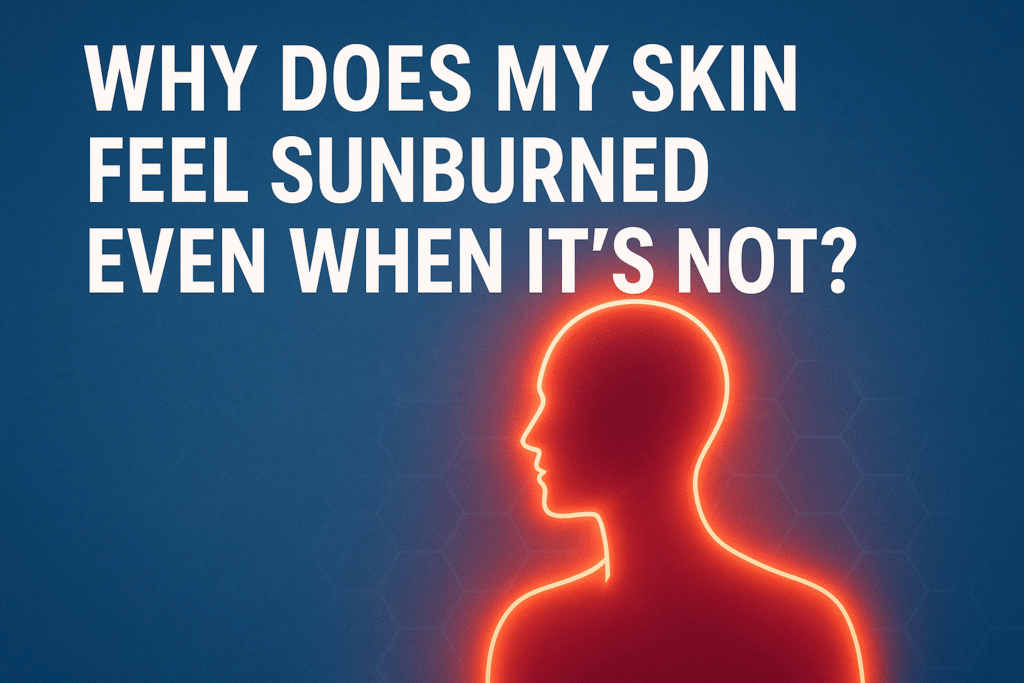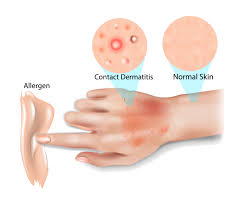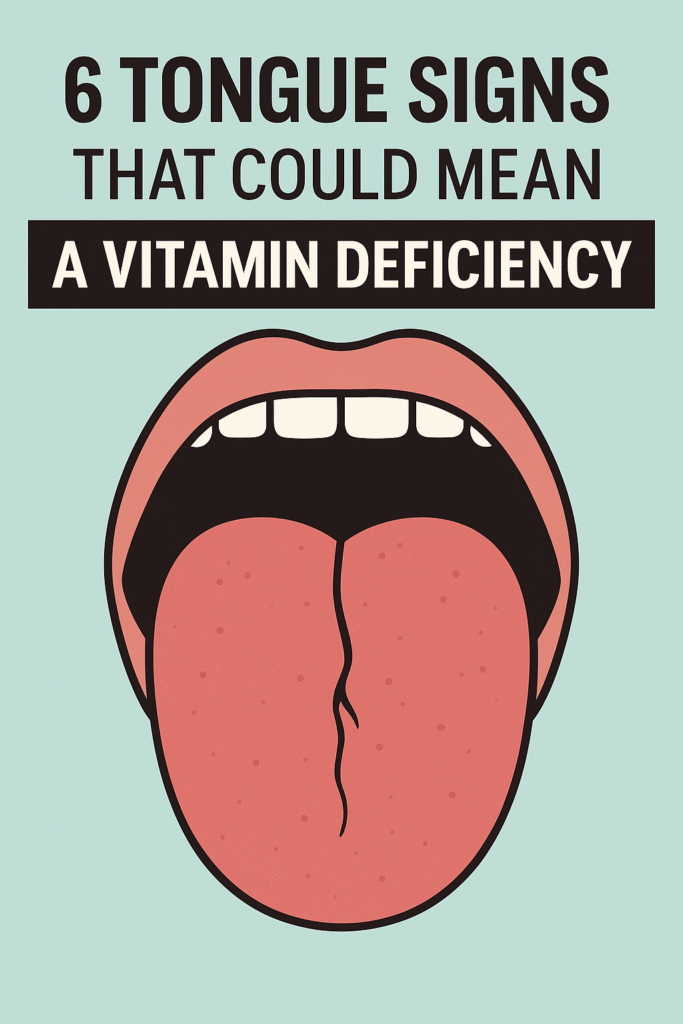
⚠️ Affiliate Disclaimer: This post may contain affiliate links, which means I may earn a small commission — at no extra cost to you — if you make a purchase through one of these links. I only recommend products or services I genuinely trust and believe can provide value. Thank you for supporting My Medical Muse!
Why Does My Skin Feel Sunburned Even When It’s Not? 7 Hidden Causes & Solutions
Have you ever felt that burning, tingling or sore sensation on your skin, just like a sunburn, even though you haven’t been in the sun? It’s confusing, uncomfortable and sometimes even frightening. You start to wonder if something’s wrong beneath the surface.
The truth is that “sunburned” feeling without an actual burn is surprisingly common and it can stem from a variety of physical, neurological and even emotional factors. Let’s break down what’s really going on, when to worry, and what you can do to calm your skin and your nerves.
What Does It Mean When Skin Feels Sunburned But Isn’t?
That sunburn-like discomfort, warmth, tingling or pain, is usually the result of nerve or skin hypersensitivity rather than heat damage. Your sensory nerves are firing off pain or heat signals to your brain, even though there’s no visible burn.
You might notice symptoms such as:
- Skin feels hot or sensitive to touch
- Mild redness or no redness at all
- Tingling, itching, or stinging sensations
- Discomfort that worsens with clothing contact or movement
This isn’t an illusion, it’s your body’s way of saying something is irritating or overstimulating your nerves or skin.
Common Reasons Your Skin Feels Sunburned Without Sun Exposure
Let’s explore the main culprits, from nerve sensitivity to hidden medical conditions that could cause your skin to feel this way.
1. Nerve-Related Causes (The Most Overlooked Reason)
One of the top explanations is nerve irritation or damage, known medically as neuropathy.
Your skin’s sensory nerves communicate sensations like heat, pain, and pressure to the brain. If these nerves become inflamed or hypersensitive, they can send false “burning” signals mimicking the sensation of sunburn.
Common nerve-related causes include:
- Peripheral neuropathy: Often linked to diabetes, vitamin deficiencies (especially B12), or alcohol overuse.
- Small fiber neuropathy: Affects tiny nerve fibers in the skin, causing burning and tenderness even without visible changes.
- Pinched nerves or nerve compression: Such as from neck, back or shoulder strain can make certain skin areas feel hot or painful.
- Post-viral nerve inflammation: After infections (like shingles or COVID-19), some people experience lingering burning sensations.
If the burning is localized (for example, on one arm or side of the face) or worsens with movement, nerve involvement is likely.
2. Skin Sensitivity or Irritation (Even Without a Rash)
Sometimes, your skin barrier, the protective outer layer becomes weakened or inflamed. This makes nerve endings more exposed, triggering discomfort.
Possible causes:
- Harsh skincare products or over-exfoliation
- Allergic reactions to detergents, soaps, or fabrics
- Fragrance or alcohol-based lotions
- Shaving irritation
- Windburn or exposure to cold, dry air
Even if you can’t see redness, microscopic inflammation may be present beneath the surface. Switch to fragrance-free, hypoallergenic skincare and laundry products for at least two weeks to see if sensitivity improves.
3. Stress, Anxiety and Cortisol Imbalance
Emotional stress can manifest physically, including in your skin. Chronic stress triggers the release of cortisol and adrenaline, which alter blood flow and increase nerve sensitivity.
That’s why some people describe their skin as burning or crawling during anxiety episodes. This is called psychogenic pruritus or stress-induced dysesthesia.
You might notice:
- The burning worsens during stressful periods
- There’s no visible rash or redness
- You also experience muscle tension, fatigue, or rapid heartbeat
In these cases, calming your nervous system (through mindfulness, deep breathing, or therapy) can make a noticeable difference.
4. Hormonal Changes
Fluctuations in estrogen, progesterone, or thyroid hormones can affect skin sensitivity and blood flow.
Examples include:
- Perimenopause or menopause: Hot flashes and skin burning sensations are common due to declining estrogen.
- Thyroid disorders: Both hyperthyroidism and hypothyroidism can make the skin feel unusually warm or tender.
If the burning comes in waves or coincides with menstrual or hormonal changes, talk to your doctor about checking your hormone levels.
5. Medication Side Effects
Some medications make your skin more reactive or interfere with nerve signaling.
Common culprits:
- Certain antibiotics (like doxycycline or ciprofloxacin)
- Chemotherapy or radiation therapy
- Blood pressure medications
- Statins (cholesterol drugs)
- Antidepressants (especially SSRIs or tricyclics)
If you started a new medication around the time your symptoms began, review possible side effects with your healthcare provider before stopping anything.
6. Vitamin and Nutrient Deficiencies
Deficiencies in key nutrients can disrupt nerve and skin health, especially:
- Vitamin B12: Essential for healthy nerve function. Low levels can cause burning or tingling sensations.
- Vitamin D: Deficiency can make your skin more sensitive and reduce its ability to repair.
- Magnesium: Supports nerve relaxation; low levels may heighten sensory sensitivity.
Blood tests can confirm deficiencies, and replenishing these nutrients often brings relief.
7. Hidden Medical Conditions
If the sensation is persistent, widespread, or worsening, it may point to an underlying health issue.
a. Fibromyalgia
A chronic pain condition where the brain misinterprets pain signals, causing burning, aching, and tenderness in the skin and muscles. Often accompanied by fatigue, poor sleep and brain fog.
b. Multiple Sclerosis (MS)
In MS, nerve insulation (myelin) is damaged, leading to abnormal sensations like heat, burning, or pins and needles. These episodes may come and go.
c. Shingles (Herpes Zoster)
Before the rash appears, shingles often starts with burning or itching in a single nerve path. The burning can last days before visible blisters show.
d. Erythromelalgia
A rare condition causing episodes of intense warmth, redness, and burning in the skin, usually the hands or feet. Triggered by heat, exercise or stress.
e. Contact Dermatitis

A delayed allergic reaction that can make your skin feel like it’s burning, even before redness appears.
If your symptoms last longer than two weeks or keep returning, don’t guess, get evaluated.
When to See a Doctor
You should seek medical evaluation if:
- The burning or pain lasts more than a few days
- It’s localized to one area and worsening
- You also experience numbness, weakness, or tingling
- There’s a rash, blisters, or open sores
- You recently started a new medication
- You have underlying diabetes, thyroid issues, or autoimmune conditions
Your doctor may perform a physical exam, blood tests, or nerve studies to pinpoint the cause.
Home Remedies and Soothing Treatments
If serious causes are ruled out, try these dermatologist-approved steps to calm your skin and nerves naturally.
A. Cool Compresses
Apply a clean, cool (not icy) compress to the affected area for 10-15 minutes. This constricts blood vessels and numbs overactive nerves.
B. Fragrance-Free Moisturizers
Use a rich, non-irritating moisturizer containing:
- Ceramides (CeraVe, Eucerin)
- Colloidal oatmeal (Aveeno)
- Aloe vera or shea butter
Avoid menthol or alcohol-based creams, they may worsen burning sensations.
C. Oatmeal or Baking Soda Baths
Colloidal oatmeal or ½ cup baking soda dissolved in warm (not hot) water can soothe inflammation and calm the skin barrier.
D. Gentle Cleansing Routine
Use mild, pH-balanced cleansers like Cetaphil or Vanicream. Avoid hot water, harsh soaps, or exfoliants until sensitivity improves.
E. Anti-Inflammatory Diet
Reduce foods that trigger inflammation and nerve irritation, such as:
- Processed sugar
- Alcohol
- Fried foods
- Excess caffeine
Increase intake of omega-3s, antioxidants, and hydration.
F. Mind-Body Techniques
Because the brain and skin are closely linked, calming the nervous system can directly reduce that burning sensation.
Try:
- Box breathing (inhale 4 sec, hold 4 sec, exhale 4 sec)
- Progressive muscle relaxation
- Meditation or yoga
- Adequate sleep and hydration
G. Over-the-Counter Relief
- Aloe vera gel: Natural anti-inflammatory
- 1% hydrocortisone cream: For mild irritation
- Topical lidocaine: Can help numb localized nerve irritation (use sparingly)
If OTC treatments don’t help within a few days, it’s time for professional guidance.
Medical Treatments for Persistent Skin Burning
If your skin continues to feel sunburned for weeks or the discomfort is intense enough to interfere with daily life, it’s time to move beyond home remedies. Chronic burning sensations often require targeted medical treatment to calm overactive nerves, reduce inflammation, and restore skin health.
Here are the most common evidence-based treatment options your doctor may recommend, depending on the cause:
a. Topical Medications
- Topical Capsaicin Cream
Capsaicin, derived from chili peppers, works by desensitizing overactive pain receptors in the skin. Although it may cause a brief burning sensation when first applied, consistent use helps reduce the intensity of nerve pain over time.
Best for localized burning from nerve irritation or small-fiber neuropathy. - Topical Lidocaine or Numbing Gels
Lidocaine-based gels or patches numb the affected nerves temporarily, providing short-term relief from surface burning and tingling.
Best for acute, localized burning sensations (for example, post-shingles or small nerve flare-ups). - Steroid Creams or Anti-Inflammatory Gels
If your doctor suspects an allergic reaction, eczema, or mild skin inflammation, corticosteroid creams (like hydrocortisone or triamcinolone) can help calm redness, swelling, and irritation.
Best for allergic, contact, or irritant dermatitis.
b. Oral Medications for Nerve-Related Burning
- Gabapentin and Pregabalin
These are first-line treatments for neuropathic pain, as they reduce abnormal nerve firing. They’re particularly effective when the burning is accompanied by tingling or sensitivity.
Typical use cases: Diabetic neuropathy, postherpetic neuralgia, small fiber neuropathy, or idiopathic nerve pain. - Antidepressants (Duloxetine, Amitriptyline, or Nortriptyline)
Although primarily prescribed for mood disorders, certain antidepressants have potent pain-modulating effects. They rebalance neurotransmitters like serotonin and norepinephrine, which regulate how the brain interprets pain signals.
Typical use cases: Chronic nerve sensitivity, fibromyalgia or burning pain related to stress and anxiety. - Anti-Inflammatory Medications
Nonsteroidal anti-inflammatory drugs (NSAIDs) such as ibuprofen or naproxen can help reduce mild inflammation that may aggravate skin or nerve sensitivity.
Note: These are more effective for inflammatory causes than for neuropathic ones.
c. Vitamin and Hormonal Therapies
When lab results reveal deficiencies or hormonal imbalances, targeted supplementation can restore proper nerve and skin function.
- Vitamin B12 injections or tablets for nerve repair and regeneration
- Vitamin D supplementation to improve immune and skin health
- Magnesium and Omega-3s to reduce nerve irritability and inflammation
- Hormone therapy (HRT) for menopausal women experiencing hot, burning, or sensitive skin due to low estrogen
d. Other Emerging Treatments
- Low-Level Laser Therapy (LLLT): Used in pain clinics to stimulate nerve healing and reduce burning sensations.
- Transcutaneous Electrical Nerve Stimulation (TENS): Gentle electrical impulses block pain signals traveling to the brain.
- Cognitive Behavioral Therapy (CBT): For stress-related or psychosomatic burning sensations, CBT helps retrain how the brain responds to sensory input.
When to Follow Up
If you start any new prescription, expect gradual improvement, neuropathic symptoms often take weeks to months to fully calm down. Regular follow-ups are essential to fine-tune dosage and prevent side effects.
Prevention and Long-Term Skin Care Tips
Once the burning subsides, protecting your skin barrier and calming your nervous system are key to preventing recurrence. The goal is to build resilience both physically and neurologically.
Strengthen and Protect Your Skin Barrier
- Moisturize Daily After Bathing
Lock in hydration while your skin is still slightly damp. Choose creams rich in ceramides, squalane or hyaluronic acid ingredients that rebuild the lipid barrier. - Use Mineral-Based Sunscreen (Zinc Oxide or Titanium Dioxide)
These provide gentle, broad-spectrum protection without irritating sensitive skin, unlike chemical sunscreens, which can sometimes trigger stinging. - Stay Hydrated
Dehydration increases skin sensitivity and reduces elasticity. Aim for consistent water intake throughout the day rather than occasional large amounts. - Get Regular Sleep and Manage Stress
Both are essential for nervous system recovery. Chronic sleep deprivation heightens pain perception and inflammation. - Eat a Balanced, Anti-Inflammatory Diet
Prioritize omega-3 fats (salmon, flaxseed), leafy greens, turmeric, berries, and whole grains to reduce inflammation and support skin repair.
Habits That Worsen Skin Sensitivity
- Overwashing or Scrubbing Your Skin
This strips protective oils and exposes nerve endings. Stick to mild cleansers and short, lukewarm showers. - Hot Showers or Baths
Excessive heat dilates blood vessels and increases nerve activation, which can mimic that “sunburned” feeling. - Fragranced Lotions, Soaps, or Detergents
Artificial scents and alcohols can aggravate already-sensitive skin. - Tight or Synthetic Fabrics
Choose loose, breathable cotton or bamboo fabrics to minimize friction and irritation.
Extra Tip: Keep a Skin Journal
Track when the burning occurs, time of day, diet, stress level, weather, or menstrual cycle phase. Patterns often reveal triggers you wouldn’t notice otherwise.
Final Thoughts: Listen to What Your Skin Is Telling You
That sunburned feeling without an actual burn isn’t in your head. It’s a signal from your nerves, your hormones or your skin barrier, that something’s out of balance.
Most of the time, it’s manageable and reversible once you identify the trigger and address it early, but ignoring it, masking it or assuming it’s nothing can allow subtle nerve or skin dysfunction to worsen over time.
Start simple:
- Simplify your skincare routine
- Manage stress and sleep
- Correct vitamin deficiencies
- Seek professional evaluation if the burning persists
Remember, your skin is deeply connected to your nervous system. When your skin feels like it’s on fire, your nerves might be asking for calm, care, or correction. Pay attention early and you’ll recover faster, sleep better and feel more at ease in your own skin.
FAQ
1. Why does my skin feel like it’s burning after a shower?
Hot water and harsh soaps strip natural oils and irritate nerve endings, especially when the skin barrier is already compromised.
Fix: Take shorter, lukewarm showers and use fragrance-free, pH-balanced cleansers like CeraVe or Vanicream.
2. Can anxiety cause skin burning?
Absolutely. Chronic stress and anxiety raise cortisol and adrenaline levels, which overstimulate the nervous system and heighten skin sensitivity.
Fix: Practice deep breathing, progressive relaxation, or short mindfulness sessions to help calm nerve overactivity.
3. Why does my skin burn more at night?
Cortisol levels naturally dip at night, increasing inflammation and nerve activity. Combined with body heat trapped under blankets, this can make your skin feel hotter and more sensitive.
Fix: Keep your room cool, wear breathable sleepwear and avoid heavy blankets.
4. Can allergies or contact dermatitis cause a “sunburned” feeling?
Yes. Allergic reactions to laundry detergents, soaps, or fabrics can cause microscopic inflammation before redness appears, mimicking a sunburn sensation.
Fix: Eliminate potential irritants one at a time and switch to hypoallergenic products.
5. Should I see a dermatologist or neurologist?
If the burning is limited to your skin or occurs after using certain products, start with a dermatologist.
If it’s widespread, accompanied by tingling or numbness, or linked to chronic pain, a neurologist can evaluate for nerve dysfunction or neuropathy.
Key Takeaways
- A sunburned feeling without sun exposure usually signals nerve hypersensitivity, stress or a weakened skin barrier.
- Vitamin deficiencies, hormonal changes, and medication side effects are common underlying factors.
- Relief starts with gentle skincare, hydration, stress management, and nutrient balance.
- Persistent or severe burning requires medical evaluation for neuropathy, hormonal imbalance, or autoimmune disorders.
- Long-term prevention means building resilience in your skin, your nerves, and your lifestyle.
👩⚕️ Need Personalized Health Advice?
Get expert guidance tailored to your unique health concerns through MuseCare Consult. Our licensed doctors are here to help you understand your symptoms, medications, and lab results—confidentially and affordably.
👉 Book a MuseCare Consult NowRelated Blog Post You Might Like:
- 5 Common Reasons Your Skin Is Burning Without a Rash: What You Should Know
- Skin Stings After Shower? 9 Powerful Natural Remedies That Work
- 12 Powerful Remedies for Itchy Skin Without Rash You Should Try
- 15 Best Natural Foods for Clear Skin and Acne (Backed by Science)
- 13 Powerful Ways Zinc Deficiency Wrecks Your Skin and Immunity (Backed by Science)
- 7 Shocking Causes of Vitamin Deficiency Tingling and Crawling Skin


